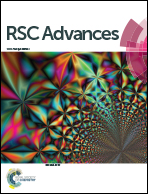Controlling the morphology and hole mobility of terpolymers for polymer solar cells†
Abstract
A series of D1–A–D2–A terpolymers based on diketopyrrolopyrrole (DPP) as electron-deficient unit (A), alkylthienyl-substituted benzodithiophene (BDTT) and thiophene-2,5-bis(2-alkyloxy)benzene-thiophene (TBT) as electron-rich units (D) have been designed and synthesized by Stille-coupling reaction. The effects of the TBT/BDTT ratios on the thermal, photophysical, electrochemical properties and crystallinity of the copolymers were investigated using thermogravimetric analysis, UV-vis-NIR absorption spectra, cyclic voltammetry and wide-angle X-ray diffraction, respectively. Compared with the binary copolymers (PDPPHT-TBT and PDPPHT-BDTT), the random terpolymers (PDPPHT-3TBT-BDTT, PDPPHT-TBT-BDTT and PDPPHT-TBT-3BDTT) exhibited significant improvement in thermal stability and hole mobility, and the optical, electrochemical properties, lamellar distance and π–π* stacking distance of the random terpolymers were successfully tuned with different TBT/BDTT ratios. Bulk heterojunction polymer solar cells based on the as-synthesized terpolymers as electron donors and (6,6)-phenyl-C61-butyric acid methyl ester (PC61BM) as the acceptor were fabricated. The best power conversion efficiency (PCE) of 4.18% was obtained from the terpolymer PDPPHT-TBT-BDTT.


 Please wait while we load your content...
Please wait while we load your content...